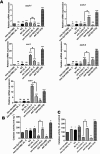ROS is the major player in regulating altered autophagy and lifespan in sin-3 mutants of C. elegans
- PMID: 29912629
- PMCID: PMC6103711
- DOI: 10.1080/15548627.2018.1474312
ROS is the major player in regulating altered autophagy and lifespan in sin-3 mutants of C. elegans
Abstract
SIN3, a transcriptional corepressor has been implicated in varied functions both as transcription activator and repressor. Recent studies associated Sin3 with the macroautophagic/autophagic process as a negative regulator of Atg8 and Atg32. Though the role of SIN3 in autophagy is being explored, little is known about the overall effect of SIN3 deletion on the survival of an organism. In this study using a Caenorhabditis elegans sin-3(tm1279);him-5(e1490) strain, we demonstrate that under in vivo conditions SIN-3 differentially modulates autophagy and lifespan. We provide evidence that the enhanced autophagy and decreased lifespan observed in sin-3 deletion mutants is dependent on ROS and intracellular oxidative stress. Inability of the mutant worms to maintain redox balance along with dysregulation of enzymatic antioxidants, depletion of GSH and NADP reserves and elevation of ROS markers compromises the longevity of the worms. It is possible that the enhanced autophagic process observed in sin-3(tm1279);him-5(e1490) worms is required to compensate for oxidative stress generated in these worms.
Abbreviations: cat: catalase; DCFDA: 2',7'-dichlorodihydrofluoroscein diacetate; GSH: reduced glutathione; GSSG: oxidized glutathione; H2O2: hydrogen peroxide; HDAC: Histone deacetylase; HID: HDAC interacting domain; him-5: high incidence of males; HLH-30: Helix Loop Helix-30; HNE: 4-hydroxyl-2-noneal; LIPL: LIPase Like; MDA: malondialdehyde; NGM: nematode growth medium; PAH: paired amphipathic α-helix; PE: phosphatidylethanolamine; RFU: relative fluorescence unit; ROS: reactive oxygen species; sin-3/SIN3: yeast Switch Independent; SOD: superoxide dismutase; NADP: nicotinamide adenine dinucleotide phosphate; SQST-1: SeQueSTosome related-1; ATG: AuTophaGy related.
Keywords: Autophagic flux; C. elegans; ROS; autophagy; lifespan; oxidative stress; sin-3.
Figures









Similar articles
-
SIN-3 as a key determinant of lifespan and its sex dependent differential role on healthspan in Caenorhabditis elegans.Aging (Albany NY). 2018 Dec 12;10(12):3910-3937. doi: 10.18632/aging.101682. Aging (Albany NY). 2018. PMID: 30541942 Free PMC article.
-
Evaluation of the antioxidant effects of acid hydrolysates from Auricularia auricular polysaccharides using a Caenorhabditis elegans model.Food Funct. 2019 Sep 1;10(9):5531-5543. doi: 10.1039/c8fo02589d. Epub 2019 Aug 16. Food Funct. 2019. PMID: 31418439
-
Overlapping and non-overlapping roles of the class-I histone deacetylase-1 corepressors LET-418, SIN-3, and SPR-1 in Caenorhabditis elegans embryonic development.Genes Genomics. 2021 May;43(5):553-565. doi: 10.1007/s13258-021-01076-1. Epub 2021 Mar 19. Genes Genomics. 2021. PMID: 33740234 Free PMC article.
-
Sin3: insight into its transcription regulatory functions.Eur J Cell Biol. 2013 Aug-Sep;92(8-9):237-46. doi: 10.1016/j.ejcb.2013.09.001. Epub 2013 Oct 9. Eur J Cell Biol. 2013. PMID: 24189169 Review.
-
Co-repressor, co-activator and general transcription factor: the many faces of the Sin3 histone deacetylase (HDAC) complex.Biochem J. 2018 Dec 14;475(24):3921-3932. doi: 10.1042/BCJ20170314. Biochem J. 2018. PMID: 30552170 Free PMC article. Review.
Cited by
-
The Molecular Mechanism of Antioxidation of Huolisu Oral Liquid Based on Serum Analysis and Network Analysis.Front Pharmacol. 2021 Nov 1;12:710976. doi: 10.3389/fphar.2021.710976. eCollection 2021. Front Pharmacol. 2021. PMID: 34790116 Free PMC article.
-
Effects of High Dietary Carbohydrate and Lipid Intake on the Lifespan of C. elegans.Cells. 2021 Sep 8;10(9):2359. doi: 10.3390/cells10092359. Cells. 2021. PMID: 34572007 Free PMC article. Review.
-
Low-Level Ionizing Radiation Induces Selective Killing of HIV-1-Infected Cells with Reversal of Cytokine Induction Using mTOR Inhibitors.Viruses. 2020 Aug 13;12(8):885. doi: 10.3390/v12080885. Viruses. 2020. PMID: 32823598 Free PMC article.
-
Efficacy of 5-aminolevulinic acid-based photodynamic therapy against keloid compromised by downregulation of SIRT1-SIRT3-SOD2-mROS dependent autophagy pathway.Redox Biol. 2019 Jan;20:195-203. doi: 10.1016/j.redox.2018.10.011. Epub 2018 Oct 17. Redox Biol. 2019. PMID: 30368039 Free PMC article.
-
Multifunctional nanomaterials via cell cuproptosis and oxidative stress for treating osteosarcoma and OS-induced bone destruction.Mater Today Bio. 2024 Feb 15;25:100996. doi: 10.1016/j.mtbio.2024.100996. eCollection 2024 Apr. Mater Today Bio. 2024. PMID: 38420143 Free PMC article.
References
-
- Kuo MH, Allis CD.. Roles of histone acetyltransferases and deacetylases in gene regulation. Bioessays. 1998. August;20(8):615–626. PubMed PMID: 9780836; eng. - PubMed
-
- Silverstein RA, Ekwall K.. Sin3: a flexible regulator of global gene expression and genome stability. Curr Genet. 2005. January;47(1):1–17. PubMed PMID: 15565322; eng. - PubMed
-
- Pile LA, Spellman PT, Katzenberger RJ, et al. The SIN3 deacetylase complex represses genes encoding mitochondrial proteins: implications for the regulation of energy metabolism. J Biol Chem. 2003. September 26;278(39):37840–37848. PubMed PMID: 12865422; eng. - PubMed
Publication types
MeSH terms
Substances
Grants and funding
LinkOut - more resources
Full Text Sources
Other Literature Sources
Research Materials
Miscellaneous
